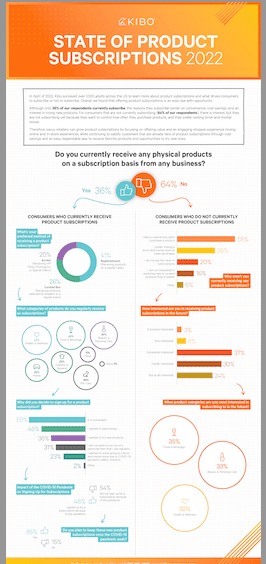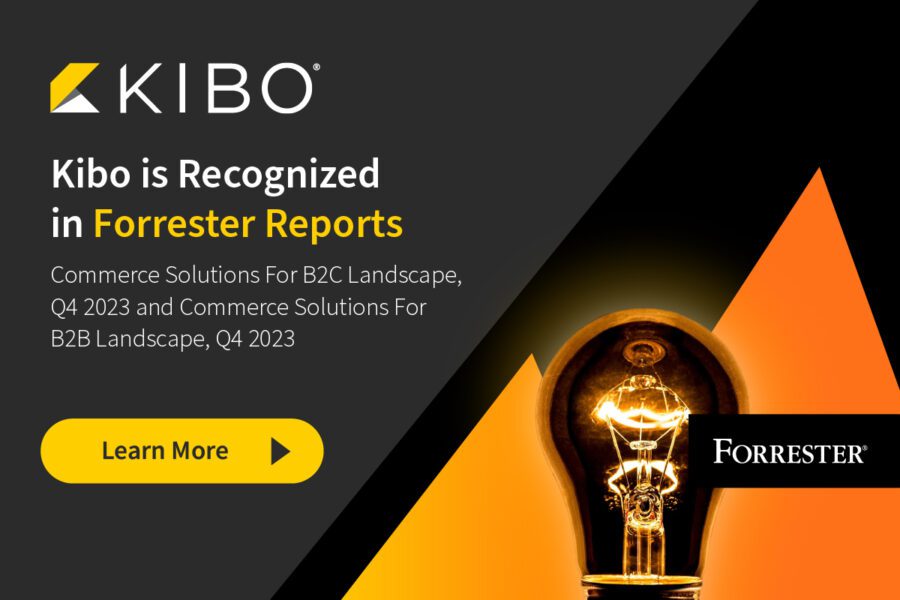The subscription craze started in the 2010s with the likes of Blue Apron and Dollar Shave Club and has since become a staple for over a third of US consumers according to a Kibo survey. Store closures due to the pandemic forced many consumers to look for other avenues to meet their everyday shopping needs. As a result, subscription eCommerce sales saw a 41% increase year-over-year in 2020.
To understand what drives consumers to subscribe or not subscribe, Kibo interviewed over 1,000 adults across the US. We asked them why they subscribe to products, what types of products they subscribe to, and if they plan to keep their subscriptions in a post-pandemic world.
In this article, we’ll outline our findings and how you can use this information to start or enhance your subscription offering.
How many consumers have product subscriptions?
36% of survey respondents have at least one product subscription. Of these respondents, 41% to Replenishment subscriptions, 20% subscribe to Access subscriptions, and 26% to Curated Boxes.

Replenishment subscriptions are ideal for shoppers that want to regularly order everyday consumable products, such as razors, snacks, or toilet paper. For example, Amazon allows Prime members to ‘subscribe & save’ to common household products and customize the delivery frequency.
With Access subscriptions, shoppers pay a recurring fee to gain access to exclusive perks, discounts, or products. For example, Fabletics charges members a monthly fee, and in return, members get access to steep discounts and free shipping.
Curated boxes typically include a select group of products chosen by the retailer and sent to the customer on a scheduled basis. Sometimes the products are set by the retailer, and in other cases the retailer personalizes the box based on a customer quiz. For example, Birchbox asks all new shoppers to complete a questionnaire to understand their beauty preferences. Based on their answers, the company curates each box to the customer’s specific needs.
As the number of consumers with a product subscription grows, savvy retailers have an opportunity to acquire new customers and reward loyal ones with convenient, frictionless subscription experiences.

Why do consumers sign up for product subscriptions?
If you’re considering offering a product subscription or looking for ways to optimize your current subscription experience, it’s essential to understand what shoppers want. When asked why they signed up for a product subscription, the top three answers were:
-
- It’s convenient.
Subscriptions offer the ultimate convenience of “setting it and forgetting it.” Especially for items that shoppers consume daily, being able to order an item once and have it delivered to your doorstep regularly ensures you’re never without your must-have item. - I wanted to save money.
Most retailers offer a discount on products if shoppers set up a recurring subscription or offer discounts on products if it’s an Access subscription. As we prepare for an economic downturn, consumers will be looking for ways to save money on the items they purchase most frequently. - I wanted to try products.
Curated boxes are ideal for consumers who want to try a few different products before committing to purchasing a full-size item. They appeal to the surprise factor of curated boxes with customers looking forward to each order.
Nearly half of respondents with a product subscription said they signed up because of the pandemic.
With store closures and mask mandates, online product subscriptions quickly became the most convenient (or only) option for consumers. 85% of these respondents plan to keep their new product subscriptions once the pandemic ends.
Why don’t consumers sign up for product subscriptions?
According to our survey results, most (64%) of US consumers don’t have a product subscription. We asked these respondents why they don’t have a product subscription, and their answers shed light on how retailers can overcome those hurdles with the right subscription strategy.
55% said they want to control how often they purchase a product
With a flexible subscriptions management solution, you can empower customers to manage their own subscriptions. For example, with Kibo Subscriptions Management, you can enable shoppers to pause orders, skip an order, swap products, order now, change frequency, and cancel.
By giving shoppers control over their subscription orders, you minimize any hesitancy or fear of dissatisfaction. Add messaging early in the buying journey that lets customers know they can customize their subscriptions based on their needs and cancel if they’re not happy or no longer need the product.
36% said they prefer visiting a brick-and-mortar store to make purchases
Entice these shoppers to try a product subscription with a discount code that they wouldn’t receive in the store. For example, you could give the shopper 10% off their first subscription order and 15% for each recurring order.
When a shopper visits a brick-and-mortar store, they have the option to buy one-off items and products they use regularly. With Kibo Subscriptions Management, they can still do both on your eCommerce site. With a mixed cart experience, shoppers can purchase subscription orders and one-time items in the same checkout flow.
Additionally, review your eCommerce site buying journey and determine if you present enough information and product images to help people feel confident in their online purchases.
Do your product detail pages have multiple product images? Is it easy for customers to navigate and filter product listing pages to find exactly what they need? By considering how subscriptions fit into the end-to-end customer experience, you can create a more frictionless path to purchase.
20% said they don’t see the value of subscriptions
Add messaging throughout the website, including the homepage and product detail pages, to help shoppers understand the benefits of your subscription offering. For example, highlight the subscription price on product detail pages and present how much the shopper will save each year by subscribing. On the homepage, prominently promote your subscription program and list out the key benefits, such as free shipping and ability to cancel anytime.
How Retailers Benefit from Offering Product Subscriptions
While customers reap the benefits of discounts and convenience with product subscriptions, retailers see several benefits as well:
- Consistent Stream of Revenue: Unlike one-time purchases, subscriptions allow you to generate a consistent stream of revenue on a scheduled basis. If you minimize subscription churn with a flexible subscription experience, you can enhance and maintain your subscription revenue.
- Consistent Stream of Customer Data: Subscriptions give you critical insights into consumer shopping trends that can feed product innovation and optimization programs. Especially if you’re asking shoppers to complete a questionnaire as part of the subscription signup, you gain a deeper insight into who your customers are and their preferences.
- Forecast Inventory Needs: By looking at subscription data points such as the most common delivery frequency customers choose, when they are most likely to pause or cancel, and what products shoppers subscribe to the most, you can better predict your inventory needs.
- Drive Customer Loyalty and Attract New Shoppers: By implementing a personalized, seamless subscription experience, you can enforce customer loyalty and leverage your brand’s biggest fans to attract new customers through word of mouth and customer reviews.
- Test New Products and Customer Segments: If your company offers curated box subscriptions, this is a great way to test new products in orders and measure how they perform based on customer feedback. You can also test new customer segments by offering product subscriptions that cater to untapped audiences. For example, if you offer a women’s shampoo subscription, you could test a shampoo subscription for men.
What Can Retailers do with Kibo Subscriptions Management?
Kibo Subscriptions Management brings value to three distinct personas: Retailers, Shoppers, and Customer Service Representatives.
Retailers: Control your subscription strategy by naming products for subscriptions and customizing subscription prices, discounts, frequencies, and trials. For example, you can offer shoppers 10% off their first subscription offer and 15% off each recurring order.
Shoppers: Give your customers a seamless and easy to manage shopping experience by allowing them to self-manage their subscription orders, including pausing subscriptions, swapping products, skipping an order, and canceling.
Customer Service Representatives: Empower your customer service representatives to help shoppers edit their subscription orders and minimize time to resolution. With Kibo Subscriptions Management, customer service representatives can create subscriptions, edit placed orders, and manage full or partial refunds.
Ready to learn more about Kibo Subscriptions Management? Schedule a demo with a member of the Kibo team to see how the solution works and can fit into your customer experience.
- It’s convenient.

Infographic: State of Product Subscriptions 2022







